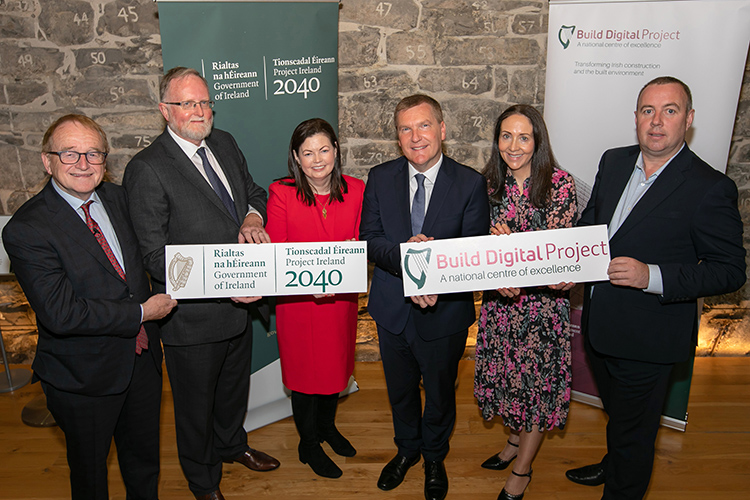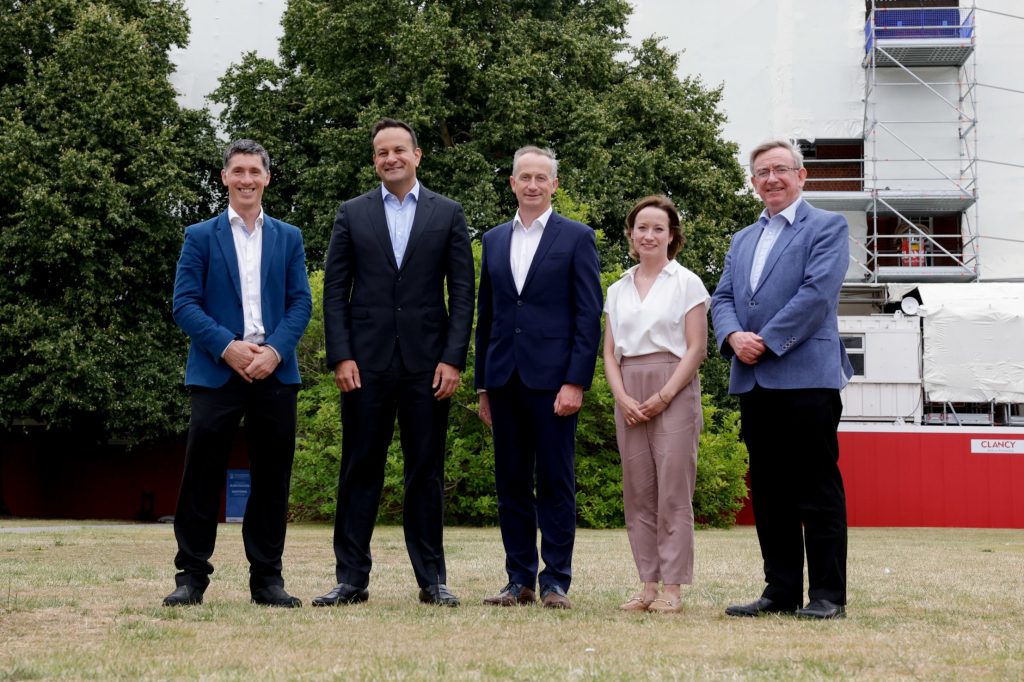Transforming the future of Irish construction – PJ Ruddden
PJ RUDDEN, Chairperson, CSG Innovation and Digital Adoption Subgroup, speaks with Robbie Cousins about the long-term impacts for Irish construction of the changes that have resulted from the work of the subgroup.
It has been three years since the Construction Sector Group (CSG) Innovation and Digital Adoption Subgroup was established in September 2020. The previous year, the Department of Public Expenditure and Reform (DPER, now called PENDR) commissioned the report. Economic analysis of productivity in the Irish construction sector, prepared by KPMG/Future Analytics. The report set out seven priority actions that needed to be implemented if the NDP was to be delivered. These actions were seen as being critical to the modernisation of the Irish construction industry, bringing it on par with more efficient sectors, such as electronics and manufacturing.
The Innovation and Digital Adoption Subgroup
Following the report’s publication, the Construction Sector Group (CSG), comprising government and industry representatives, set up the Innovation and Digital Adoption Subgroup to implement the seven priority actions. The CSG appointed PJ Rudden, former president of Engineers Ireland, as chairperson of the subgroup to oversee the implementation of the actions.
The seven priority actions are:
- Establish construction research needs
- Identify funding sources for future innovation, eg circular economy in construction (Sustainability)
- Guide the development of Modern Methods of Construction (MMC)
- Establish a Construction Technology Centre (CTC) as a national research centre of excellence
- Establish a digital network under the Construction Professional Skillnet Ireland
- Digitise the planning permission application system
- Establish and fund a Build Digital Project (BDP) for BIM and digital adoption

“Looking back at the subgroup now, it is a remarkable achievement involving some 300 highly motivated and capable people from across stakeholders in the construction sector, who all collaborated to get the work done.
“But before addressing that and what the next steps might be, I want to quickly summarise the circumstances that led to this point.”
We need a plan
Rudden explains as a prologue that around 2012, when he and other consultants/ contractors had to chase work in the UK because the industry was on its knees here, they were shocked to learn that there was a government mandate for them to be operating at BIM level 2 to be considered for public sector contracts.
“While the industry in Ireland had stood still, the rest of the world was moving forward. But we realised that Ireland would have to follow suit, as within a few years, the same scenario would be happening in here. And it did happen; driven by the tier-1 contractors, BIM became a key project tool on all large projects in Ireland. But we knew from that time on, if the Irish sector was to lift itself and achieve any momentum, it would need to modernise, and when I say modernise, I mean completely change how it did its business.”
The National Development Plan 2018- 2027, published in 2018, set out the government’s investment priorities to underpin the implementation of a National Planning Framework 2040. These two programmes combined to form Project Ireland 2040.
The CSG was established in 2018 to facilitate regular and open dialogue between the government and the construction sector and to identify areas for action to ensure the success of the NDP.
PJ Rudden continues, “With the establishment of the CSG, the government recognised that the construction industry was broken and couldn’t have been expected to suddenly deliver on the then €116bn, later €165bn, worth of infrastructure and housing targeted in the NDP. “It should be noted that the 2018 €116bn programme was a bold statement of ambition from the government. But the government also realised that there was no way it could have an NDP in this detail with such a large investment budget without at the same time setting up a new relationship with the construction industry, one that hadn’t existed previously.”

Project Ireland 2040 Delivery Board
PJ Rudden explains that another government intervention saw him appointed to the Project Ireland 2040 Delivery Board for the NDP earlier last year. This meant that he was able to take a twin-track approach, further removing the silos that had previously held progress back.
“The NDP Delivery Board was reconfigured by the then DPER Minister Michael McGrath, who brought in some new faces from the private sector. Earlier this year, his successor as minister, Paschal Donohoe, reduced the board to eight people comprising five new industry people and three secretary generals as well as the minister as chair.”
He adds that Minister Donohoe said at the time that he was keen to get the views of the membership of the group, particularly in recommending reforms to boost NDP delivery, and that was why he took the step of personally chairing the delivery board to drive project delivery.
“As chair of the delivery board, the minister asked what needed to be done to further accelerate the NDP. The board agreed that planning, digital and skills were particular issues to be addressed. We all hope that recent changes to the new Planning and Development Bill, currently before the Oireachtas, will help to speed up planning decisions and reduce the number of appeals.
“The minister has since announced that Building Information Modelling (BIM) would be mandated for projects over €100m from January 2024.
“His chairing of the NDP Delivery Group has resulted in a real boost to the pace of change. The department’s name was also changed to the Department of Public Expenditure, NDP Delivery and Reform to reflect the increased focus on NDP delivery.”
BIM adoption
Discussing BIM, PJ Rudden notes that the sector has reached a point where it is, for the most part, comfortable working with BIM levels 2 and 3, but it needs to move quickly to BIM 3D and through the other levels to BIM 7D Operational BIM.
“We then need to get to the point of being comfortable at levels 6 and 7 on embedded and operational BIM, particularly with the challenges we face in reducing carbon emissions where we have to reduce our emissions by 50% by 2030.”
He adds, “Further to the BIM mandate from January, when the Office of Government Procurement (OGP) looks at tenders, in addition to quality and costs, they will examine the embodied carbon and the usage of cement and concrete with a bias towards lower embodied carbon.
“Getting to BIM levels 6 and 7 will be essential to reduce carbon emissions of buildings and infrastructure, both embedded and operational carbon, to conform with the 2023 Climate Action Plan.”
The Seven Priority Actions
Returning to the delivery of the seven actions, PJ Rudden is delighted about how the industry has collaborated and delivered over the past three years.
He comments, “Work on the seven actions has been running in parallel. As I am now on the NDP Delivery Board, this gives us far more firepower than we previously had. We are now not just a subgroup of the CSG; we are, at the same time, delivering on the seven priority actions in parallel with the objectives of the NDP Delivery Board.
“Action 1, ‘Establish construction research needs’, feeds into Action 4, ‘The establishment of Construct Innovate, the Construction Technology Centre’ by Enterprise Ireland.
“Construct Innovate, led by the University of Galway, now has 44 member companies and is funding research with initial priority on housing, with all the technological and academic universities being brought in to collaborate with industry.
“Action 2, ‘Sustainability’, has its committee about to publish a much-anticipated circular-economy roadmap for construction, which will also become the national roadmap, endorsed and facilitated by the Department of Environment, Climate and Communications.
“Action 3, ‘Prepare a guide for MMC’: The Department of Enterprise Trade and Employment headed up this work. It prepared a report on where the MMC sector was at and where it needed to go.
“The department is now implementing an MMC roadmap developed from the first piece of work and looking at the whole area of materials testing, compliance and standards to give quality assurances that weren’t there previously. A new MMC Division in the NSAI now oversees Agrement certifications for MMC systems.
“The roadmap includes the creation of MMC demonstration parks. I am delighted that Laois Offaly ETB has already built an MMC Demonstration Park in the Mount Lucas Training Centre. I would like to see this model expanded with further demonstration parks across the country.
“Action 5, the ‘Digital Skills Network’, is progressing under the Construction Professional Skillnet, which now offers Level 7 BIM courses to everyone interested in the sector.
“Action 6 is ‘ePlanning’. Every local authority will accept digital planning submissions by the end of next June. It should be noted that by the end of this year, 37 local authorities will be at this stage with only six counties to go, including the larger Dublin and Cork local authorities.
“Action 7 is Build Digital Project led by TU Dublin, and much has been achieved here with international links established. This unit is now collaborating with the OGP to prepare for the BIM Mandate from 01 January 2024. TU Dublin is now being paired with a new partner, the Grangegorman Development Authority, which is expected to accelerate performance based on its experience of digital construction.”
No one left behind
Summing it up, PJ Rudden comments, “You might ask why this wasn’t done before this. And the answer is, ‘We simply did not have the manpower, skills or ambition to do the things that needed to be done to fix construction in Ireland. But we now have those skills and experience. We now have far more experienced people in our industry, and nobody can be left behind.
“We have been able to rebuild the construction industry engine, and we’re now applying that reconditioned engine to accelerating housing and infrastructure roll-out.
“The government’s goal has been to remove key constraints on the delivery of NDP projects, in terms of resourcing, the planning system, and increasing the capacity of public sector bodies in a leadership role. It is bringing the private sector with it to deliver the plan and, in the process, expanding our digital technology skills, building housing more quickly, and addressing skills deficiencies in the public and private sectors.
“We have put the machinery in place to achieve this. And it is essential to understand that this has been done with the intention of taking everyone along on the journey.
“Remember, 95% of the industry are SMEs, who are already embedded in major contract work. So many of them know what they need to upskill on, and for those that don’t, they will have the support to start their digital transition journey.”
End to boom-bust cycles
So, will this bring an end to the boom-bust cycles of the past?
Rudden comments, “We have a national housing and infrastructure budget of €165bn ringfenced for a 10-year period, and this will have to be supplemented in the next decade. The industry is now assimilating all the skills it needs to deliver in a more efficient and cost-effective manner.
“From the time the Housing for All strategy was published, there was a real cross-departmental push to make this happen. Several government departments are playing key roles, one example being the Department of Further and Higher Education and the Department of Enterprise, Trade and Employment working together to ensure that future skills needs will be met.
He continues, “2040 is nearly only 15 years away. The government has shown its commitment to supporting the delivery plan, and I do not expect this to change regardless of what happens in the future.”
The two future driving forces
PJ Rudden says that the speed at which the sector as a whole can adopt and incorporate BIM and MMC into its operations will be telling.
“The two driving forces of the NDP in the future will be BIM and MMC. If you have digital design transferring over to digital construction, you’re taking it off-site and away from poor weather and ground conditions into office and factory environments.
“Another part of this conversation has been the need and push to greatly improve gender balance. Moving work offsite into factories, offices, and studios will mean that there will be a minimum number of people on site, making them safer.
“With more skilled people working under controlled factory conditions in large offsite facilities using digital tools and skills they have learned, quality and efficiency will be greatly improved. It will also make construction a much more attractive career choice for more men and women.”
He closes by saying, “There is no doubt that construction is changing. With the modernisation and the innovations happening now, I am sure it will become an even more exciting place for young people to pursue life-long, stimulating and rewarding careers,” PJ Rudden concludes.




